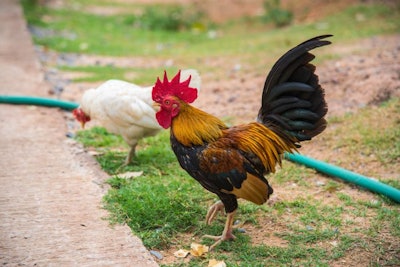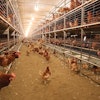
The selection of performance traits in meat birds (body weight for age) and laying hens (egg production and egg weight) have resulted in the need to feed for increased structural integrity. For example, changes in egg production husbandry practices, such as alternative housing systems and the use of perches in the laying house, have created higher incidence of keel bone fractures.
While there is no question that genotype by diet interactions exist for important meat-related traits, such as breast yield, a large portion of the nutrient needs by modern strains are met by simple increases in feed intake in response to selection for growth. However, the same may not necessarily be true of strains selected for egg production. Genetic increases in egg production have largely been accomplished with minimal changes in body weight and/or feed intake.
Effects of phytase
The industry’s knowledge of nutrition has advanced to the point where specific nutritional requirements are better understood and the bird can be fed to meet those needs. However, the more we know, the more we need to know. Today’s typical poultry diet will likely contain phytase with its ability to release phytin phosphorus and reduce the negative impact on mucus secretion and chelation of cations (positively charged), e.g. calcium (Ca), magnesium (Mg), zinc (Zn) which can impact cation:anion (negatively charged) balance and subsequent performance.
The effect of phytase on mineral utilization is beginning to be understood. Recent work done at the University of Illinois indicated that phytase addition to a grow/finish pig diet increased standard total tract digestibility of calcium 2 to 7 percent. This suggests that the digestibility of various cations may be increased when phytase is included in a diet and that increase should be taken into consideration in practical formulation.
Does raising either calcium or phosphorus levels increase the magnesium requirement of the chick? Does this mean that poultry may respond to supplemental Mg in today’s phytase-containing diets?
Magnesium: a closer look
Magnesium is an important element in the skeletal matrix and plays a significant role in nerve stimulation and muscle contraction. It is a catalyst in about 400 different enzymes/systems involved in protein, lipid and carbohydrate metabolism. Magnesium is required for insulin secretion and is a cofactor in the production of glutathione peroxidase, an important antioxidant in the body’s immune system.
Magnesium oxide (MgO) is the highest Mg-concentration mineral that is readily available as an animal feed ingredient. Not all sources of MgO are equal to the task of providing the necessary Mg+ ion efficiently to a living organism. Solubility, reactivity and bio-availability are all characteristics that differ from one MgO product to another.
Calcined caustic magnesia (CCM) is produced by burning off CO2 from magnesite (magnesium carbonate), resulting in MgO.
Two factors affect the quality of the MgO:
- The temperature at which magnesium carbonate is exposed to burn off (calcine) carbon dioxide.
- The duration of time at which magnesium carbonate is exposed to that heat.
Both factors are optimized when calcined in a Hershoff furnace, which results in the production of a highly reactive “light burn” MgO (most bio-available) versus a “harder burn” MgO (much less bio-available) or a “dead-burn” MgO (non-bio-available) produced from furnaces with less control of time and temperature.
A light burn MgO supplemented to an animal’s diet will typically provide the best magnesium bio-availability and subsequent assimilation of Mg+ ions.
Magnesium reactivity, an indicator of animal bioavailability, may be measured by a T-50 test (measures reactivity under approximate constant pH conditions) or a test of CMA (caustic magnesia activity), which measures the time required to neutralize a certain amount of acetic acid.

Comparison of MgO values from various countries show that the lower the test values, the more reactive and more bioavailable the MgO source. | Premier Magnesia L.L.C.
MgO for hen skeletal integrity, egg weight
The nutrient requirements of minerals in broilers, layers or turkeys have not been extensively studied since the publication of the last National Research Council Nutrient Requirements of Poultry in 1994. Recent trials with egg strain pullets and layers and mixed sex broilers suggest that the addition of Mg can improve performance and skeletal integrity.
A recent study conducted at The Ohio State University suggests the addition of highly reactive MgO in a phytase-free diet increased body weight in Hyline-36 pullets and hens, gave greater bone strength in 6- and 12-week-old pullets, and had an effect on egg weight during the 33- to 36-week period of lay.
The researchers evaluated the effect of adding 2 pounds of a “highly reactive” MgO per ton to commercial-type pullet and layer diets. The addition resulted in heavier body weights at 18 weeks (1.216 kilograms vs. 1.193 kilograms; P=0.039) and 21 weeks (1.370 kilograms vs. 1.343 kilograms; P=0.077) of age, respectively.
Bone strength measured as bone density by quantitative computed tomography (QCT) was increased (P=0.065) in 6- and 12-week-old pullets fed 0.1 percent supplemental MgO. Hens fed this Mg level had ~1 percent heavier eggs (61.9 grams vs 61.2 grams; P=0.071) during the last lay cycle (33 to 36 weeks of age).
MgO improves broiler performance
Highly reactive MgO added to broiler diets increased body weights and improved feed conversion in 42- and 49-day broiler floor pen trials conducted at a private research facility.
In the first trial, 42-day body weight and tibia ash and breaking strength were significantly increased and feed conversion improved by Mg addition.

The addition of reactive MgO to the diets of 42-day-old broilers significantly (P < 0.05) improved 42-day body weight and feed conversion ratio by ~3 and ~2, percent, respectively. The impact MgO addition on bone strength related variables was relatively greater, resulting in ~7.5 and ~4, percent, increases in tibia bone ash and tibia bone breaking strength, respectively. | Nelson, 2015
Broilers fed diets containing phytase suggest that their performance to 42 days of age may be optimized with the addition of 2 to 3 pounds of highly reactive MgO/ton of feed, while it appears that adding 3- to 4-pounds MgO/ton of feed may be needed to maximize bone strength. Supplemental Mg positively affected performance in the second trial with the addition of 1.5- to 2-pounds MgO/ton giving improvements on 49-day body weight (70 g.; 2.7 percent), feed conversion (3.0 points; 1.5 percent) and tibia bone ash (7+ percent).

Adding reactive MgO to the diets of 49-day old broilers significantly (P < 0.05) improved 49-day body weight and feed conversion by adding Mg to the diet significantly (P < 0.05) improved ~3 and ~2, percent, respectively, while its addition increased tibia bone ash by ~8.6 percent. | Nelson, 2015
Livability was significantly improved in the 42-day broiler trial by added dietary Mg, but not in the second trial. Blood glutathione peroxidase (GSH px) levels were measured in trial 2 and increased in a linear manner compared with the negative control with the response levelling off at 2 pounds MgO/ton. The differences in the maximal responses of the variables measured (body weight, feed conversion, tibia bone ash, tibia breaking strength, GSHpx) suggest that the Mg “requirements” may differ for each system and change with age.
Conclusions
More research will be needed to better understand the optimal levels of dietary magnesium and other minerals in phytase-containing poultry diets. The importance of cost-effective feed additives such as highly reactive MgO which can benefit skeletal strength and integrity will only increase in the future. Findings indicate that the addition of 2 to 3 pounds MgO/ton of poultry diet will improve performance. The data suggest that higher levels (3- to 4-pounds/ton) may be needed in younger broilers to optimize bone strength.
A better understanding the value of supplemental magnesium on immunity, carbohydrate metabolism and various enzyme systems will be needed to fully unlock its suspected and untapped potential.
References available upon request

















